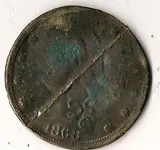You are using an out of date browser. It may not display this or other websites correctly.
You should upgrade or use an alternative browser.
You should upgrade or use an alternative browser.
What the heck is it?
- Thread starter montanagold
- Start date
lostcauses
Bronze Member
Magic token??
Some of them were hollow.
Some of them were hollow.
jeff741972
Hero Member
- Joined
- Sep 13, 2008
- Messages
- 508
- Reaction score
- 95
- Golden Thread
- 0
- Location
- Tamaqua Pa
- Detector(s) used
- V3i
Braided Hair, or Late Dates (1839–1857)
Facing more negative public reaction, the Coronet cents were redesigned in 1839 by new Chief Engraver Christian Gobrecht. This last major change to the coin updated the obverse by giving Liberty a slimmer, more youthful appearance. Minor tweaks continued through 1843, and the 1843 design prevailed through the end of mintage in 1857. Some 11 years after the large cent was discontinued, a mint employee coined several large cents dated 1868, almost certainly for sale as instant rarities to numismatists. Fewer than a dozen of these unofficial issues, struck in both bronze and copper-nickel, are known to survive.
Found that info on wikipedia
Facing more negative public reaction, the Coronet cents were redesigned in 1839 by new Chief Engraver Christian Gobrecht. This last major change to the coin updated the obverse by giving Liberty a slimmer, more youthful appearance. Minor tweaks continued through 1843, and the 1843 design prevailed through the end of mintage in 1857. Some 11 years after the large cent was discontinued, a mint employee coined several large cents dated 1868, almost certainly for sale as instant rarities to numismatists. Fewer than a dozen of these unofficial issues, struck in both bronze and copper-nickel, are known to survive.
Found that info on wikipedia
Argentium
Gold Member
- Joined
- Feb 2, 2008
- Messages
- 9,058
- Reaction score
- 5,575
- Golden Thread
- 0
- Location
- Santa Fe, New Mexico
- Detector(s) used
- Whites, MXT.
- Primary Interest:
- All Treasure Hunting
I think a reverse pic is necessary here , interesting find for sure ! Argentium.
jeff741972
Hero Member
- Joined
- Sep 13, 2008
- Messages
- 508
- Reaction score
- 95
- Golden Thread
- 0
- Location
- Tamaqua Pa
- Detector(s) used
- V3i
Am I the only one who noticed the date on that? It maybe some kind of knock off "collector copy" thing.
From what I found there is like 12 known for that date, cant really imagine one being bent in half then unbent.
From what I found there is like 12 known for that date, cant really imagine one being bent in half then unbent.
Newt
Bronze Member
Spooky said:Newt said:Hammered copper! Imprint maybe from a real copper penny onto sheet copper?
Newt
i thought that TOO, but wouldn't it be a "reverse image?"
If they layed the copper on top it would imprint the image the same, Right?
Newt
dwayne sueno
Bronze Member
- Joined
- Mar 18, 2008
- Messages
- 1,103
- Reaction score
- 17
- Golden Thread
- 0
- Location
- upstate ny
- Detector(s) used
- se pro
- Primary Interest:
- Other
the image is a copy of a gold $20 piece, not a copper. without a pic of the back, hard to tell what it would have been used for.
montanagold
Sr. Member
- #9
Thread Owner
I thought it was more like a 20 dollar gold piece because it is the size of a half and large cents are more like a quarter, It is just strange that the detail is there but it is so thin. I couldn't imagine someone hammering copper on a gold coin. that would damage the heck out of it.
montanagold said:I thought it was more like a 20 dollar gold piece because it is the size of a half and large cents are more like a quarter, It is just strange that the detail is there but it is so thin. I couldn't imagine someone hammering copper on a gold coin. that would damage the heck out of it.
My guess is that it was part of a gold-plated period counterfiet of a gold coin. One method of counterfeit was to emboss a sheet of copper onto the front and back of a good coin, solder the two halves together, fill with lead for weight, the carefully fix the edge as best as possible. The finished counterfeit was gold plated, and passed off as a real gold coin.
The design is identical to the 1868 $20 double eagles of that year, and the thickness suggests it's either a copper chocolate coin shell, or a counterfeit shell. =)
Greg
mountainplayer
Hero Member
- Joined
- Oct 10, 2006
- Messages
- 634
- Reaction score
- 99
- Golden Thread
- 0
- Location
- Way Northern California
- Detector(s) used
- Ace 250 & Minelab EX2
I think hammong nailed it. Montanagold, you're right, but in 1868 a $20 gold coin was worth $20, regardless of condition. If I was trying to multiply my money I wouldn't mind banging up a gold piece to do it. You might just have an awesome example of a really rare counterfeit gold coin. Bet there aren't too many of those around.
What is the history of the site where it was found?
MP
What is the history of the site where it was found?
MP
dwayne sueno
Bronze Member
- Joined
- Mar 18, 2008
- Messages
- 1,103
- Reaction score
- 17
- Golden Thread
- 0
- Location
- upstate ny
- Detector(s) used
- se pro
- Primary Interest:
- Other
hammong said:montanagold said:I thought it was more like a 20 dollar gold piece because it is the size of a half and large cents are more like a quarter, It is just strange that the detail is there but it is so thin. I couldn't imagine someone hammering copper on a gold coin. that would damage the heck out of it.
My guess is that it was part of a gold-plated period counterfiet of a gold coin. One method of counterfeit was to emboss a sheet of copper onto the front and back of a good coin, solder the two halves together, fill with lead for weight, the carefully fix the edge as best as possible. The finished counterfeit was gold plated, and passed off as a real gold coin.
The design is identical to the 1868 $20 double eagles of that year, and the thickness suggests it's either a copper chocolate coin shell, or a counterfeit shell. =)
Greg
i want to like this idea, but i'm not so sure. the image on the outside is too clear for someone having hammered out the metal to make the INTERIOR create a passable cast. note the small dots around the rim. too precise for the face that is not casting an image. but perhaps this piece was a step in the counterfeiting process?
Similar threads
Users who are viewing this thread
Total: 1 (members: 0, guests: 1)

 ? Thanks
? Thanks
